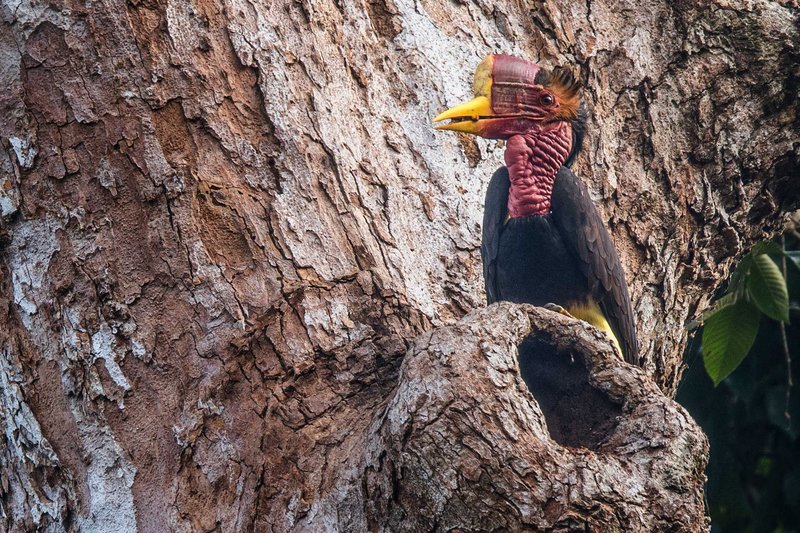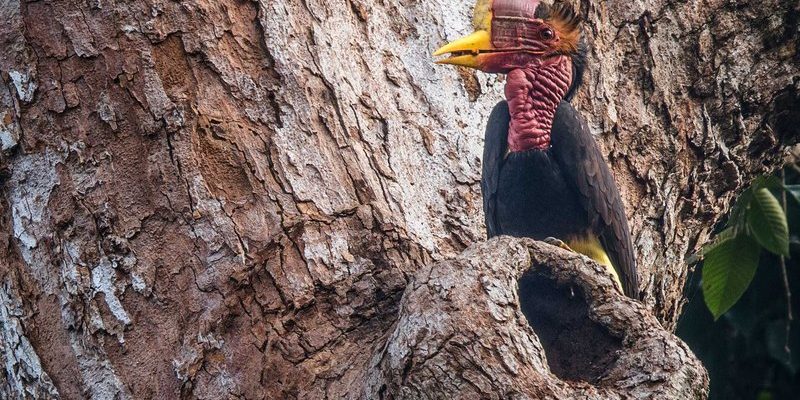
Imagine stepping into a vibrant rainforest, where the air is thick with chatter and the colors are alive with hues you didn’t even know existed. Among the many creatures flitting about, one stands out with its unique bill and lively personality—the hornbill. These birds, found in the tropical forests of Africa, Asia, and the islands of the Indian Ocean, are a true marvel of nature. With around 57 species, hornbills are not just beautiful; they play crucial roles in their ecosystems.
Hornbills are easily recognizable thanks to their large, curved bills, which can be quite striking. These colorful bills serve various purposes, from attracting mates to cracking open fruit. It’s like having a Swiss Army knife attached to their faces! As we get to know these remarkable birds, you’ll see how they are more than just their looks—they’re vital contributors to forest health and regeneration.
So, whether you’re an aspiring ornithologist or just curious about the natural world, let’s dive deeper into the lives of hornbills. We’ll explore their habitats, diets, behaviors, and everything that makes these birds so special.
The Fascinating Anatomy of Hornbills
When you first lay eyes on a hornbill, their distinctive bill grabs your attention. This bill isn’t just for show; it’s packed with functionality. Depending on the species, these bills can range from a few inches to nearly two feet long! Can you imagine walking around with something that big on your face? The bill is made of a lightweight structure, allowing them to fly gracefully despite its size.
In addition to their impressive bills, hornbills have strong, sturdy bodies, which are typically adorned with striking plumage. The colors and patterns can vary significantly between species, serving not only to attract mates but also to camouflage them in their natural habitat. The contrast of dark feathers with vibrant accents can be a painter’s palette come to life! Hornbills also possess strong legs and zygodactyl feet, which means they have two toes pointing forward and two pointing backward, making it easier for them to grip branches securely.
Another interesting feature? Their unique nesting behavior. Female hornbills often seal themselves inside tree cavities during the breeding season. They use mud and droppings to block the entrance, only leaving a small opening for the male to bring food. Isn’t that a wild way of ensuring safety and giving privacy while raising their young?
Hornbills and Their Habitat
Hornbills thrive in lush environments where they can find plenty of food and shelter. Their primary habitats include tropical and subtropical rainforests, although some species can also be spotted in savannas and mixed forests. This is a place where nature is at its finest, with a rich tapestry of life surrounding them.
The trees in these forests are vital. Hornbills depend on them not just for nesting but also for food. Their diet mainly consists of fruits, insects, and small animals. They have been known to munch on a variety of fruits, including figs, which are a favorite among many species. Picture this: hornbills flying gracefully from tree to tree, their large bills skillfully plucking fruit, and scattering seeds all around. They play a crucial role in seed dispersal, helping to maintain the health of their ecosystem.
Interestingly, hornbills are very sensitive to changes in their environment. Deforestation and habitat destruction are major threats to their survival. The loss of trees means less food and fewer places to nest. This makes conservation efforts essential, ensuring these stunning birds can continue to thrive in their natural homes.
Diet and Feeding Habits of Hornbills
Hornbills are omnivores, which means they have a diverse diet that allows them to adapt to their surroundings. While they primarily feast on fruits, they won’t hesitate to munch on insects, small birds, or even small mammals when the opportunity arises. It’s like having a buffet at their disposal, and they often choose what’s fresh and in season.
Eating is quite an event for hornbills! Their large bills not only help them reach fruit high up in trees but also allow them to crack open hard-shelled nuts. It’s impressive to watch them work; you can often see them skillfully maneuvering their bills to access just the right snack. And they don’t just eat indiscriminately; they have favorites! Certain species have been observed favoring specific fruits, which can create a fascinating dynamic in their feeding habits, as they tend to flock to areas where their preferred food is abundant.
Interestingly, hornbills have a special relationship with some tree species. As they eat, they help in the dispersal of seeds, which contributes to forest regeneration. This mutual relationship emphasizes the importance of hornbills in their ecosystems, making them crucial players in the survival of various plant species.
Social Structure and Behavior
Hornbills are social creatures that often live in groups. These groups can vary in size, depending on the species and the availability of resources. Being social helps them protect themselves from predators and allows them to cooperate while foraging for food. You might see them engaging in playful activities, like chasing each other around the canopy.
During the breeding season, however, their dynamics shift slightly. The male and female pair up and engage in elaborate courtship displays. The males often perform aerial displays, showcasing their impressive flying skills and vibrant plumage to woo potential mates. It’s a beautiful dance of nature, filled with color and motion. After mating, the female seals herself in a nest hole, leaving the male to bring her food. This unique behavior promotes teamwork and care, ensuring the safety of their young.
You might find it fascinating that hornbills communicate through a variety of calls and sounds. Their vocalizations can range from deep hoots to sharp, high-pitched sounds. These calls serve multiple purposes—from warning other hornbills of danger to coordinating their movements while foraging. It’s a symphony of sounds, much like a well-rehearsed orchestra, each member contributing to the harmony of their environment.
Conservation Status and Threats
Despite their fascinating nature, hornbills face numerous threats in the wild. Deforestation, hunting, and habitat fragmentation are significant issues impacting their populations. As forests disappear, so do their homes and food sources. This leads to a decline in their numbers, raising concerns among conservationists.
Several species of hornbills are classified as threatened or endangered due to these challenges. Protecting their habitats is crucial for their survival. Conservation programs worldwide are working hard to raise awareness and implement strategies to preserve hornbill populations. Initiatives like reforestation and the establishment of protected areas have shown promise, but more action is needed.
As enthusiasts, it’s important to support conservation efforts and spread awareness about the plight of hornbills. Every small action counts—whether it’s sharing information, supporting eco-friendly practices, or even visiting conservation areas. You can play a role in protecting these magnificent birds and their habitats.
Unique Hornbill Species
The world of hornbills is rich with diversity, with each species exhibiting its own unique traits and characteristics. One of the most well-known is the Great Hornbill (Buceros bicornis), which is easily recognizable by its impressive yellow bill and striking black feathers. This species can be found in the forests of Southeast Asia and is often seen flying gracefully through the canopy.
Another fascinating species is the Trumpeter Hornbill (Bycanistes bucinator), which stands out with its bold markings and flexibility in diet. These birds are not only beautiful but also play a vital role in their environment, making them key players in maintaining the balance of their ecosystem.
Then there’s the African Grey Hornbill (Tockus nasutus), known for its small size and grey-brown plumage. They have a slightly more diverse diet, which can include small vertebrates and insects, allowing them to adapt to various habitats across Africa. With around 57 species of hornbills, the variety in appearance and behavior is genuinely remarkable, making each one a unique marvel in its own right.
Table of Hornbill Facts
| Species | Size | Habitat | Diet | Lifespan |
| Great Hornbill | 25-52 inches | Tropical rainforests | Fruits, insects, small animals | Up to 50 years |
| Trumpeter Hornbill | 16-20 inches | Forests and savannas | Fruits, insects | Up to 30 years |
| African Grey Hornbill | 16-21 inches | Woodlands, savannas | Fruits, small vertebrates | Up to 20 years |
Frequently Asked Questions
What do hornbills eat?
Hornbills primarily have an omnivorous diet. They enjoy a variety of fruits, insects, and sometimes small animals. Their preference varies by species, with some favoring specific fruits. This adaptable diet helps them thrive in their lush habitats.
How do hornbills nest?
Nesting behavior in hornbills is quite unique. After mating, the female will seal herself inside a tree cavity using mud and droppings, leaving only a small opening for the male to deliver food. This protective measure is vital for keeping their young safe during the critical early stages of development.
Are hornbills social birds?
Yes, hornbills are generally social. They often live in groups that can vary in size based on species and habitat. This social behavior helps them protect against predators and enhance their foraging success.
How do hornbills communicate?
Hornbills communicate using a variety of vocalizations, including hoots and chirps. These sounds serve different functions, such as alerting others to danger or coordinating movements while foraging. Their calls create a lively atmosphere in their habitat.
What threats do hornbills face?
Hornbills face significant threats, including habitat destruction due to deforestation, hunting, and environmental changes. These factors contribute to declines in their populations, making conservation efforts critical to their survival.
How long do hornbills live?
The lifespan of hornbills varies by species, but some can live quite long—up to 50 years in the case of the Great Hornbill. Lifespan can be influenced by factors such as habitat conditions, availability of food, and threats from predators.
Are hornbills endangered?
Several species of hornbills are indeed classified as threatened or endangered. Conservation programs are actively working to address the challenges they face, emphasizing the importance of protecting their habitats and raising awareness about their plight.
What role do hornbills play in the ecosystem?
Hornbills serve as important seed dispersers in their ecosystems. As they eat fruits and nuts, they help spread seeds across the forest, contributing to plant regeneration and the overall health of the forest. Their role is vital for maintaining the balance within their habitats.
Can hornbills fly well?
Absolutely! Hornbills are strong flyers, despite their large bills. Their wings are adapted for graceful flight, allowing them to navigate through the dense canopy of their forest habitats with agility and ease.
Where can I see hornbills in the wild?
Hornbills can be found in various regions across Africa and Asia, particularly in tropical rainforests and woodlands. Birdwatching tours in these areas can provide a fantastic opportunity to observe these magnificent birds in their natural habitat.
How can I help hornbills?
Supporting conservation efforts, spreading awareness, and choosing sustainable practices are great ways to help hornbills. You can also contribute to organizations dedicated to protecting their habitats and ensuring their survival for future generations.

